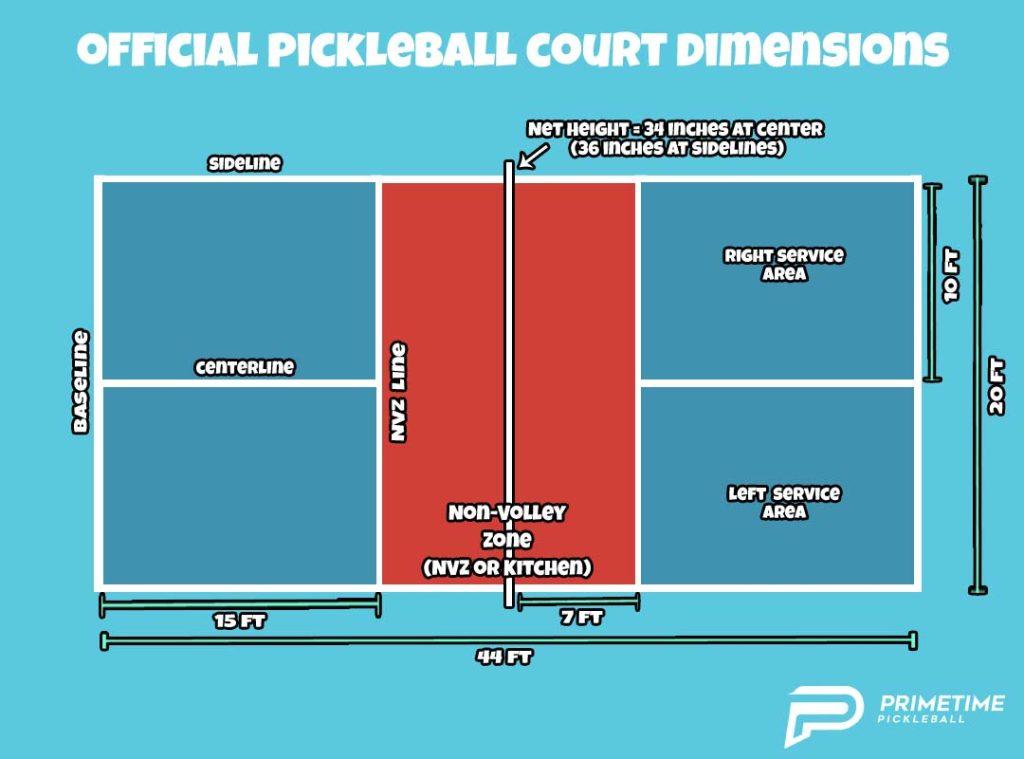As in all sports, there are rules specific to the game that outline how we can play to allow for fun, fair and competitive play.
A key and distinctive feature of pickleball rules when compared to other sports, is that there is an area close to the net that is referred to as the kitchen.
The official name for this area is the non-volley zone.
For some, it is a nightmarish zone that fills them with terror while others find it to be a strategic zone, that offers plenty of game-winning opportunities.
Here’s what you need to know about the pickleball kitchen rules, dimensions and how you can exploit it to benefit your next pickleball match.
What is the Kitchen in Pickleball?
In pickleball, “The Kitchen” refers to the area just in front of the net that is marked out by the kitchen line (a.k.a the non-volley zone line).
The non-volley zone (NVZ) affectionately called the “kitchen” represents an area into which you cannot go if you plan on volleying the ball. That is its main purpose.
One of the more unusual pickleball terms is the “kitchen”. Some think the name may be attributed to the game of shuffleboard, where you lose ten points when your puck lands in a zone also referred to as the “kitchen” or the “10-off” area. But nobody can quite confirm or deny where the term came from with any level of confidence.
Pickleball does seem to have a lot of borrowed elements from other sports so it’s not that surprising in this regard.
How Big is The Kitchen?
The pickleball court lines that mark out an area adjacent to the net on either side extend back 7 feet from the net and run 20 feet wide parallel to the net. These dimensions includes the width of the line marking as well and they are about two inches wide.
When serving, your ball must land beyond your opponents non-volley zone, including the NVZ line. If the ball bounces inside the kitchen, then it is considered a fault, and the opposing player or team wins the point.

Kitchen Rules For Pickleball
The official pickleball rules governing the kitchen can be confusing for players new to the sport.
This is especially true of tennis players who train to approach the net with the very purpose of volleying. It takes a little while for this ingrained habit to wear off when playing pickleball.
However, there are only two specific conditions that relate to playing in the kitchen. Once you have internalized these 2 rules, dealing with the non-volley zone becomes a lot easier.
Pickleball Non-Volley Zone Rules
When hitting shots, there are only two primary instances on the court which do not allow you to volley the ball.
They are:
- If you stand in the kitchen or on the kitchen line and hit the volley.
- If you’re standing behind the line as you hit the volley but the momentum from hitting the volley causes you to step in the kitchen to catch your balance.
The specific pickleball kitchen rules make the following further stipulations regarding volleying:
- During the act of volleying, both feet must be:
- Outside the non-volley zone (kitchen)
- Outside the non-volley zone both before and after you’ve hit the volley.
- You may not touch the non-volley zone or the non-volley line with a finger or toe, or any part of your body.
- You can also not allow your paddle, clothing, or accessories to touch the non-volley zone or line when you are volleying.
A volley is defined as a ball that is hit before it has had a chance to bounce on the ground after it crosses over the net towards the receiving player.
Faults in the Non-Volley Zone
If you fail to follow the non-volley zone rules, you are penalized by losing the point.
Here are a few situations that may occur during a game that will earn you a fault:
- You run into the non-volley zone and execute a volley.
- You run towards the non-volley zone and your momentum carries you forward into the kitchen after performing a volley outside the kitchen.
- You step into the kitchen as you hit the volley.
- Your paddle hits the ground inside the non-volley zone as you perform the volley.
- You touch the ground inside the non-volley zone with your other hand as you perform the volley (this can happen if you lose your balance).
- You drop your paddle into the non-volley zone after hitting the volley.
- If you step into the non-volley zone due to your momentum carrying you over the line even if the ball is dead or it’s a fault by your opponent.
- If you drop anything such as a cap, sunglasses, or keys into the kitchen while executing the volley.
- You are in the kitchen or on the NVZ line with any part of your body, you jump, hit the volley while airborne over the kitchen but land outside the non-volley zone or out of bounds. That is still considered a fault because you did not have both feet established outside the kitchen before the volley.
- During a doubles pickleball game, you touch your partner who is in the non-volley zone, while volleying (even when you are outside the kitchen).
- You strike your doubles partner’s paddle during the volley shot and they are standing in the non-volley zone.
What Can You Do in The Kitchen?
Despite the rules being very clear about what you cannot do in the non-volley zone, there are many disputes about what you can do.
To clear some of these issues up, here’s a list of some of the things you are permitted to do in the kitchen:
- You can step into the non-volley zone after hitting a volley as long as it’s not your momentum from hitting the volley that carried you into the NVZ.
- You can step through the non-volley zone and volley outside the court, so long as you establish both feet outside the non volley zone before making contact with the volley.
- You can step over, or jump over the non-volley zone on your way to making a volley and landing outside the court.
- You can volley a ball above the non-volley zone so long as you don’t step into it (you can legally reach over the non-volley zone without touching it).
- The rules only apply to volleys, so you can step into the kitchen to play a ball that bounces inside the non-volley zone. You do not have to wait for the ball to bounce in order to enter the kitchen. This is a common misconception. You can enter before it has bounced as long as you hit it after the bounce.
- You can stay in the non-volley zone for as long as you want. There is no limit. The only proviso is that you do not hit a volley while in the kitchen so you’d be well advised to get out before the next shot comes back from your opponent.
How to Best Position Yourself In or Out of The Kitchen?
It is well worth remembering that the majority of points are won by players while up at the non-volley zone line.
Strategically, it’s more advantageous to be closer to the net because you will have more opportunities to play aggressive shots from there thus increasing your chances of winning the point if you play things right.
For this reason, it is imperative that you strategically move toward the kitchen line, to take advantage of this strong court position closer to the net.
The focus is on moving to the line in such a way that you do not leave yourself open to passing shots or high lob shot that push you back off the NVZ line into the back area of the court on your side.
5 Tips to Exploit the Non-Volley Zone
1. Moving as a Team
In doubles, your partner should be about 6-8 feet away from you when you approach the non-volley line. In this way, you can both cover the maximum amount of court space.
It is difficult to hit a passing shot when the two of you are positioned like this.
Always keep an eye out for where your partner is positioned and adjust your position accordingly.
2. Toe the Line
To take control of the court and the game, you need to aggressively make an effort to keep returning to the line, even when you are driven off it by your opponents.
When you are forced to take steps back and to the side, continue to try to move back to the dominant line position.
3. Give Up Part of the Court
When playing doubles, you and your partner will cover at least two-thirds of the court when you stand with a gap of 6-8 feet between you.
If you effectively follow the flight of the ball, the open part of the court that you are not covering will be much more difficult for your opponents to attack. As you close of angles to them, the open spots available are very difficult to hit successfully.
They will only be able to take low-percentage shots into this area and it will produce many more forced and unforced errors.
4. Forehand Shots Should Take Preference
Doubles players must communicate effectively before and during the game. Partners should decide ahead of time how they will allocate shots when at the non-volley line.
As forehands can produce stronger shots so, typically though not always, the player with their forehand in the middle should play shots received down the middle.
5. Play Dinks Towards Your Opponent’s Feet
The most difficult shots to return are dinks that land at your opponent’s feet.
When positioned at the non-volley zone line, attempt to play the ball as close to your opponent’s non-volley zone line as possible.
If you can do that and place the ball bouncing at your opponent’s feet, then it forces them to decide if they will volley it or let it bounce. No matter what they decide, they will often be at least slightly jammed up while hitting it, unless they make quick decisions which is not easy to do time and time again.
This may put you in a stronger position for the next shot as your opponent will be concentrating on not faulting their shot rather than attacking you.
They will be on the defensive and you may get a chance to dominate soon if you keep the jammed up repeatedly.
Final Thoughts
While the rules regarding the non-volley zone and hitting volleys are not as straightforward as one might imagine, it doesn’t take too long to learn them.
Just keep in mind that you cannot volley in the non-volley zone or while touching any of the lines that make up the non-volley zone.
You can also not make contact with the non-volley zone after hitting a volley if its your momentum from hitting the volley that carries you into that zone. This contact extends to your paddle, clothing, body parts, accessories, and your partner in doubles games.
If you enjoyed these beginner pickleball tips to improve your pickleball game, and want 3 keys to a killer 3rd shot, click here to learn these secrets.

 Dior 2024 Women's Pearl Earrings
Dior 2024 Women's Pearl Earrings  Chanel earrings, CC earrings adorned with pearls v41
Chanel earrings, CC earrings adorned with pearls v41  Chanel earrings, CC dangle earrings in water drop shape adorned with stones and pearls v39
Chanel earrings, CC dangle earrings in water drop shape adorned with stones and pearls v39 